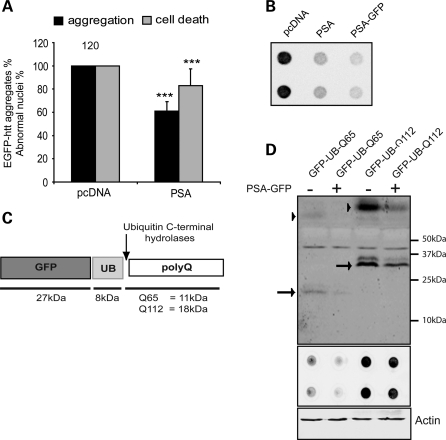Figure 2.
PSA overexpression reduces toxicity and aggregate content in cells expressing expanded polyQ huntingtin exon 1 and expanded polyglutamine tracts. (A) Effect of PSA overexpression on aggregate content in SK-N-SH cells expressing htt-exon-1-Q74-GFP. The proportions of cells with GFP-positive macroaggregates and apoptotic nuclei were decreased by the overexpression of PSA, when assayed as in Figure 1A and C. Data shown are normalized to control for each experiment and the average of data from four independent experiments carried out in triplicate are shown. In control conditions, typically around 30% of transfected cells contained macroaggregates and 10% had apoptotic nuclei. ***P < 0.001 by odds ratio. (B) Overexpression of PSA in 293T cells also decreased levels of insoluble aggregates of htt-exon-1-Q103-GFP, as measured by filter-trap assay. Q103 aggregates were visualized using anti-GFP antibody. (C) To mimic the polyQ sequences that may be released by the proteasome, we used a GFP–ubiquitin–polyQ construct (23). Upon expression, the GFP–UB and the polyQ peptide are efficiently cleaved by deubiquitinating enzyme(s), leading to the release of a polyQ polypeptide. (D) Levels of soluble and insoluble polyglutamine peptides were also decreased by overexpression of PSA in HEK293T cells transfected with GFP–UB–polyQ containing 65 or 112 glutamines. Levels of both soluble polyQ peptides (upper panel, arrows mark monomeric polyQ peptides and arrowheads mark high molecular weight oligomeric structures) and insoluble aggregates (lower panel) detected by an anti-polyglutamine antibody decreased, when PSA-GFP was co-transfected. Actin levels are shown as a loading control.

